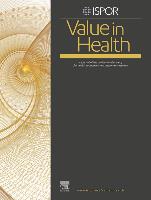Report by Leaders of ISPOR Special Task Force on US Value Assessment Consider the History and Future of the Report’s Value Elements
 Lawrenceville, NJ, USA—April 11, 2022—Value in Health, the official journal of ISPOR—The Professional Society for Health Economics and Outcomes Research, announced today the publication of a report showing that 4 years after the 2018 ISPOR Special Task Force on US Value Assessments published its recommendations meant to advance value assessment methods, researchers have provided more rigorous theoretical and mathematical foundations for some novel value elements while others continue to lag behind. The report, “The History and Future of the ‘ISPOR Value Flower’: Addressing Limitations of Conventional Cost-Effectiveness Analysis,” was published in the April 2022 issue of Value in Health.
Lawrenceville, NJ, USA—April 11, 2022—Value in Health, the official journal of ISPOR—The Professional Society for Health Economics and Outcomes Research, announced today the publication of a report showing that 4 years after the 2018 ISPOR Special Task Force on US Value Assessments published its recommendations meant to advance value assessment methods, researchers have provided more rigorous theoretical and mathematical foundations for some novel value elements while others continue to lag behind. The report, “The History and Future of the ‘ISPOR Value Flower’: Addressing Limitations of Conventional Cost-Effectiveness Analysis,” was published in the April 2022 issue of Value in Health.
In 2018, the ISPOR Special Task Force on US Value Assessments published recommendations intended to help broaden the view of value in healthcare and spur new research on incorporating additional elements of value in traditional cost-effectiveness analyses. The members of the Special Task Force leadership group were Peter J. Neumann, ScD, Center for the Evaluation of Value and Risk in Health at the Institute for Clinical Research and Health Policy Studies, Tufts Medical Center, Boston, MA, USA; Louis P. Garrison, PhD, University of Washington School of Pharmacy, Pharmaceutical Outcomes Research and Policy Program, Seattle, WA, USA; and Richard J. Willke, PhD, Chief Science Officer, ISPOR, Lawrenceville, NJ, USA.
Specifically, the Special Task Force identified and considered 12 potential elements of value, including 2 core elements (net costs and quality-adjusted life years), 2 common but inconsistently used elements (productivity and adherence-improvement) and 8 potentially novel ones (reduction in uncertainty, fear of contagion, value of insurance, severity of disease, value of hope, real option value, equity, and scientific spillovers). These 12 elements came to be known as the “ISPOR Value Flower.” In the past few years, the value flower, with its petals highlighting elements that may be overlooked or underappreciated in conventional drug value assessments, has been discussed and debated widely.
Now, years after the Special Task Force published its recommendations, the leadership group—Drs Neumann, Garrison, and Willke—have authored this important update describing recent developments and considering implications for future value assessments.
“Our review of conceptual and empirical papers published in the past 4 years shows that researchers have provided more rigorous theoretical and mathematical foundations for certain novel value elements (eg, severity of disease, value of insurance, value of hope) through generalized risk-adjusted cost-effectiveness analysis, which incorporates risk aversion in people’s preferences and uncertainty in treatment outcomes,” said the authors. “Empirical estimates are also emerging to support key elements, such as value of insurance, real option value, value of hope, and value of knowing.”
While health technology assessment bodies have applied, or are considering certain elements as described above, other elements have yet to gain traction. The authors note that in part, the lack of uptake may simply reflect the recency of the Special Task Force report and other research. But it may also reflect other factors: a relative dearth of empirical estimates to support novel elements, the difficulties of changing established practices, the absence of strong incentives for US payers to consider non-health effects and externalities, an unwillingness of health insurers to consider elements such as option value or scientific spillovers because they rely on yet undiscovered innovation, or skepticism in the field.
“Five years after the Special Task Force began its work, the development of novel value measures continues to evolve,” the authors note. “While it is encouraging to see supporting empirical studies emerging, more are needed. Additional efforts are also needed to illustrate how the estimates can be used in the deliberative processes that are integral to health technology assessments. Finally, it would be worth revisiting the design of the ISPOR value flower itself. Considerable discussion of value frameworks has continued without a consensus on any one specific parsing and identification of all the potential elements. Including novel elements will not solve all issues related to value measurement in healthcare. But they can help us think more clearly and comprehensively about the tradeoffs that individuals and societies are willing to make in their choices.”
Additional information on ISPOR’s work on value assessment can be found on the Society’s Value Assessment Frameworks webpage.
###
ABOUT ISPOR
ISPOR, the professional society for health economics and outcomes research (HEOR), is an international, multistakeholder, nonprofit dedicated to advancing HEOR excellence to improve decision making for health globally. The Society is the leading source for scientific conferences, peer-reviewed and MEDLINE®-indexed publications, good practices guidance, education, collaboration, and tools/resources in the field.
Website | LinkedIn | Twitter (@ispororg) | YouTube | Facebook | Instagram
ABOUT VALUE IN HEALTH
Value in Health (ISSN 1098-3015) is an international, indexed journal that publishes original research and health policy articles that advance the field of health economics and outcomes research to help healthcare leaders make evidence-based decisions. The journal’s 2020 impact factor score is 5.725 and its 5-year impact factor score is 6.932. Value in Health is ranked 4th of 98 journals in health policy and services, 9th of 108 journals in healthcare sciences and services, and 24th of 376 journals in economics. Value in Health is a monthly publication that circulates to more than 10,000 readers around the world.
Website | Twitter (@isporjournals)